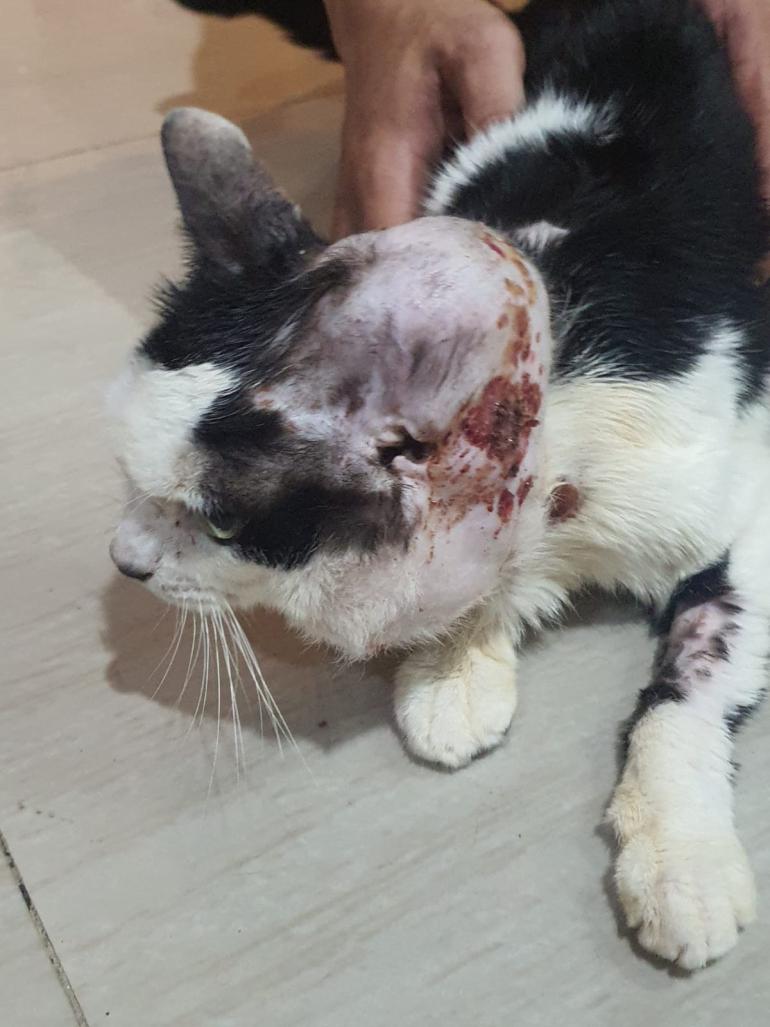Brain tumour or cancer in Cats: Causes, Symptoms, Diagnosis, and Treatment

Brain tumors in cats, although relatively rare, can significantly impact a cat's health and quality of life. Understanding the causes, recognizing the symptoms, and exploring the available diagnostic and treatment options are essential for cat owners and caregivers. This article provides comprehensive insights into brain tumors in cats, aiming to raise awareness and facilitate informed decisions about their feline companions well-being.
Brain tumour or cancer in cats
Regretfully, cats can develop brain tumors just as frequently as people do. Unfortunately, brain tumors are incurable in the majority of animals and can cause terrible illnesses. As of right now, the only available treatments aim to prolong the animal's life and enhance its quality of life. Regretfully, your pet will eventually pass away from any brain tumor.
What is a brain tumour?
An abnormal cell development inside a human tissue is called a tumor, sometimes known as cancer. Brain cancers can arise from primary brain tumors, which are brain cells that have begun to grow uncontrollably, or they can be the result of a tumor that has migrated to other parts of the body.The most common primary brain tumors are those that originate from the brain parenchyma itself (glioma), the choroid plexus (choroid plexus tumour), the ventricle lining (ependymoma), or the lining of the brain's surface (meningioma).
Cancerous fragments from other parts of the body may separate from their main source and enter the brain through the bloodstream, where they settle and begin to spread. Animals with brain tumors typically exhibit symptoms as a result of the tumor pressing against the surrounding healthy brain tissue as it grows. Both inflammation and brain damage result from this.
What are the signs of a brain tumour?
The symptoms of brain tumors in cats can vary based on the tumor's location, size, and rate of growth. Common signs include:
-
Altered Behavior: Cats may display changes in behavior, such as increased aggression, disorientation, or altered sleep patterns.
-
Seizures: Recurrent seizures, ranging from mild to severe, are a common symptom of brain tumors.
-
Head Pressing: Cats might press their heads against walls or other objects due to increased intracranial pressure.
-
Loss of Balance: Cats may exhibit a lack of coordination, difficulty walking, or circling in one direction.
-
Vision Problems: Brain tumors can cause vision impairment or complete loss of vision in affected cats.
-
Lethargy and Weakness: Cats may appear lethargic, have a decreased appetite, and show overall weakness.
Different clinical indications can be caused by brain tumors, depending on the area of the brain that is afflicted. Seizures, or fits, are frequently the first symptoms to appear.Seizures that are generalized are frequently very severe, resulting in the cat collapsing, drooling copiously, thrashing around, and sometimes even emptying its bladder and intestines. There are less severe types of seizures known as partial seizures, which can be identified by a range of symptoms such as twitching of the face or limbs, salivation, weakness on one side of the body, unsteadiness, altered speech or behavior, etc.
Regretfully, it seems likely that these seizures will never stop. Additional symptoms that are frequently observed include blindness, temperamental changes in cats, extreme lethargy, circling, and disorientation. It could seem to some that their cat is experiencing a headache. Similar to seizures, some of these symptoms could not go away no matter what kind of treatment you choose.
How will my vet know that my cat has a brain tumour?
Diagnosing a brain tumor in a cat involves a combination of methods:
-
Physical and Neurological Examination: The veterinarian assesses the cat's overall health and neurological function, looking for specific signs associated with brain tumors.
-
Imaging Studies: MRI (Magnetic Resonance Imaging) or CT (Computed Tomography) scans provide detailed images of the brain, helping identify the tumor's location, size, and characteristics.
-
Cerebrospinal Fluid Analysis: Analyzing cerebrospinal fluid obtained via a lumbar puncture can provide additional information about the presence of abnormal cells or substances indicative of a brain tumor.
The symptoms you mention may lead your veterinarian to believe that your pet has a brain tumor. Standard X-rays cannot show the brain, thus in order for your veterinarian to take photographs of your pet's brain, certain diagnostic tests must be performed. Brain imaging using either an MRI or CT scan is the foundation for the diagnosis of brain tumors. While these tests are highly effective in identifying the existence of a mass in the brain, they are not particularly excellent in determining the precise type of mass (e.g., tumor, inflammation, or even internal bleeding).
To rule out brain inflammation, a sample of the fluid around the brain may need to be obtained. In rare instances, this may indicate the existence of lymphoma, a specific kind of cancer. A tissue sample needs to be obtained in order to determine the precise etiology of the tumor and, in the event that cancer is present, the degree of malignancy. A biopsy needle can be inserted into the skull to acquire this material. If the mass is to be surgically removed, a sample might be taken right before the procedure.
Severe tumors have the potential to metastasize, or spread throughout the body. Both malignancies from other locations (particularly the lung, liver, prostate, and mammary gland) and brain tumors have the potential to metastasize to the chest. It could be required to have abdominal ultrasonography and chest and abdomen X-rays to make sure the cancer is not spread to other parts of the body.
Can brain tumours be treated?
Brain tumors can be treated thanks to developments in veterinary treatment for animals, but sadly, not all tumors can be healed. Generally, the goal of treatment is to provide your pet the best possible life for the longest amount of time. Your cat should be given medication to control seizures if they are occurring, regardless of the course of treatment you choose, as these seizures are probably going to be permanent.
How can brain tumours be treated?
The prognosis and course of treatment for brain tumors differ depending on the kind of tumor. Several criteria, including as the patient's overall health and the type of tumor, determine the best course of action for each individual. There are three fundamental approaches to treating tumors:
-
Medication on its own
Because the brain is a highly protected area and most medications cannot pass through it, there are relatively few chemotherapy alternatives available for brain tumours. Nonetheless, some of the symptoms experienced by a patient with a brain tumor may be lessened with treatment. Drugs to lessen the intensity and frequency of seizures as well as anti-inflammatory medications (corticosteroids) to lessen swelling and pressure brought on by the tumor may be recommended. In certain instances, this could significantly reduce the animal's symptoms and improve its overall health. This method is inexpensive and unlikely to harm your pet, but in certain circumstances, it might only offer temporary respite for a few months.
-
Radiation therapy and medication
While many cat brain tumors are benign—that is, slowly growing and unlikely to spread—and can be surgically removed, some are deeply ingrained and carry a high risk of surgical error. Radiation therapy can cause indications to improve dramatically and quickly. For the majority of pets, the advantages of this treatment exceed the hazards.The majority of animals do not experience any negative effects from the radiation therapy, yet on rare occasions, nausea, mouth ulcers, ear infections, and blindness may occur. Additional medicine can help control the majority of radiation side effects. A longer time of good quality of life can be achieved with radiation treatment in addition to medication than with medication alone. Sadly, radiation seldom eliminates the tumor entirely, and a typical remission lasts between eight and fourteen months before the cancer returns.
-
Medication, radiotherapy, and surgical procedures
The whole removal of the tumor is the ultimate aim of cancer surgery. Regretfully, brain tumors rarely allow for this to happen, and cancer cells are almost always left behind, which fuel the tumor's growth. Nonetheless, the surviving cells may become more radiation-sensitive if the tumor is surgically removed as much as feasible. The backbone of treatment for the majority of human brain tumors is the polytherapy strategy, which combines medication, surgery, and radiation. The goal of treatment is to surgically remove the majority of the tumor to increase the efficacy of subsequent treatments.
Additionally, surgery enables the veterinarian to remove a sample of the tumor and determine its type, which may facilitate the process of providing a more precise prognosis for the patient. The viability of surgically removing a brain tumor varies according on its location within the brain. Surgery has a higher chance of being effective for brain tumors that are on the surface. A significant portion of the patient's healthy brain tissue would need to be removed for the surgeon to access a malignancy that is located deep within the brain, which could have disastrous consequences for the patient's prognosis.
The most expensive and invasive option is surgery. Brain surgery can, in rare cases, result in lasting brain damage, despite the fact that most cats recover successfully and without complications. Following surgery, some pet owners claim that their animal's behavior and personality have altered. There is a danger associated with brain surgery, especially if the patient has other medical issues because a prolonged anesthetic is required. There are times when a patient may not fully recover from surgery. This strategy has the advantage of possibly giving your pet the longest term of high quality life.
Will my pet suffer during treatment?
Prolonging the time a pet has a high quality of life is the goal of treatment for a brain tumor in pets. If your pet is not happy, your veterinarian will not want to give them more time to live. Before your pet begins treatment and at every turn, talk to your veterinarian about all of your worries. You will always be the one to decide when your pet is pleased or not. Asking your veterinarian to put your pet to sleep right now is the best course of action.
How long will my pet live?
It can be very challenging to estimate how long an animal with a brain tumor will live, as this depends on a number of factors, such as the type of cancer and how quickly it grows, the size and location of the tumour inside the brain, and the treatment that is used.Even though many animals with brain tumors only live for a few months after being diagnosed, they can still lead healthy lives with the right support. In the event that you choose to pursue treatment, this period of time may assist you in accepting your pet's condition and creating treasured memories.Generally speaking, the usual duration of remission with corticosteroids alone is 1 to 6 months; with radiation alone, it is 8 to 14 months; and with surgery followed by radiotherapy, it is 12 to 20 months.
Conclusion
Brain tumors in cats present significant challenges for both cat owners and veterinarians. Recognizing the early signs, seeking prompt veterinary care, and exploring appropriate treatment options are crucial steps toward providing the best possible quality of life for cats diagnosed with brain tumors. Through awareness, understanding, and compassionate care, cat owners can support their feline companions during this difficult time, ensuring they receive the love and attention they need.



